Perfect Squat Hand Position in 5 Steps
Author:
Reviewed by:
(21 years of Oly Lifting experience)
Unlock your full potential by engaging with our experts and community! Have questions about your fitness journey or looking for expert advice on weightlifting techniques? Don’t hesitate — leave a comment below and Jacek Szymanowski will provide a personalized answer and insights to help you reach your goals.
Torokhtiy is reader-supported. Some links are affiliate links, and we may earn a commission at no extra cost to you. See our disclosure page for details.
When you hear the words ‘squat hand position’, even though there are all kinds of squat variations (e.g., front squat, sumo squat, overhead squat, zercher squat, etc.) your mind probably jumps to back squats, which makes sense given that back squats are the most popular ones.
And that’s exactly what we’re dealing with today – how to position your hands during back squats.
You probably already know exercising is all about form. If you can’t get that right, your workouts won’t be as effective and you can kiss any real progress goodbye. Hand positioning is one of the things you need to master to get your form to be correct, so stick around because we’ll break down everything about it. You’ll learn the ropes on different types of grips, bar placement, and you’ll also get some tips on how to keep your wrists happy because, well… Wrists don’t really like squats as much as you do.
Get ready to up your squat game and master the back squat hand position!
What is the correct squat hand position? It depends on your comfort level and fitness goals. One common choice is the regular grip, where you place your thumbs around the bar. You can also try thumbless or talon grips, but make sure your wrists can take it.
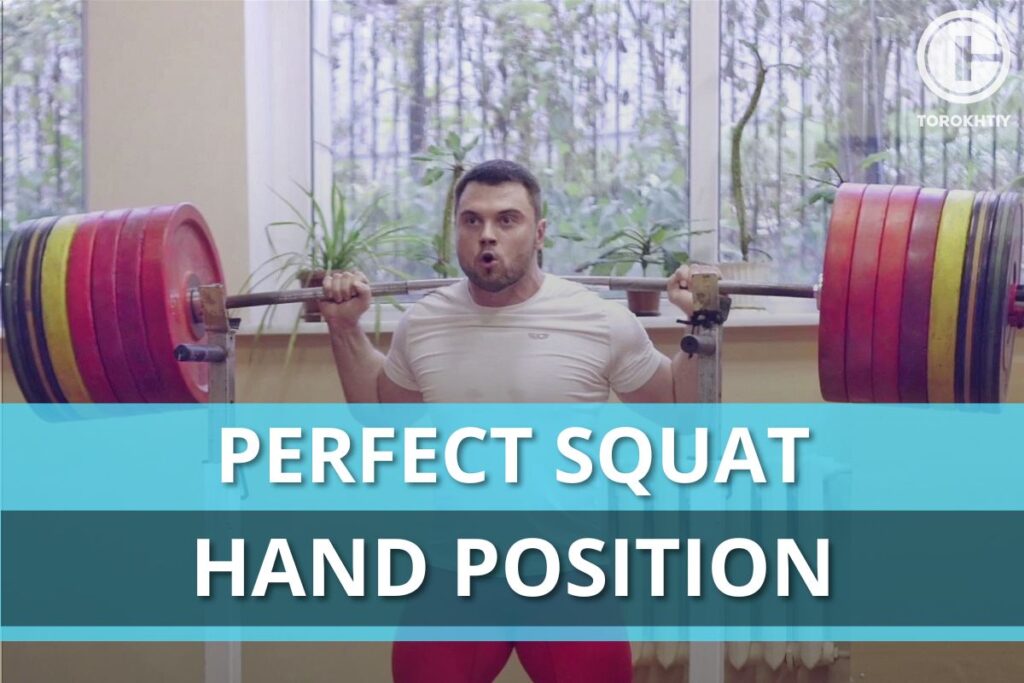
How to Position Your Hands During a Squat?
Back squats are a good way to improve your athletic performance, but only if you do them right. Imagine a lifter squatting and their bar starts wobbling and shifting because their hand placement was off. That’s a pretty disturbing picture and it can happen to anyone who doesn’t get how important it is to place your hands properly.
There’s a few things that go into this, but in short, you need a secure grip to support the weight of the barbell. The choice of grip is something we’ll get into a little bit later, but it’s good to know that the grip you choose to use directly influences how the bar sits on your back during squatting.
You start your squat by standing with your feet shoulder-width apart, and toes pointed out a little if you want. As you lower into the squat, hinge at the hips, bend your knees, and keep your back straight. The bar should move in a vertical path over the middle of your feet.
Your hands play a big role in keeping the bar stable and preventing it from rolling forward or backward but also keeping your upper back tight and stable. When your hands are placed just right, the weight is distributed evenly, and you have more control over your movement. Squats depend on a stable foundation, and your hands are sort of anchors in this process.
Follow us!

Free!
Get a 2-week Weightlifting Program as a bonus for the subscription to kickstart your training plan!

Free!
Step 1: Choose Your Grip
Correct squat hand placement starts with choosing the right grip, and if you’re a beginner, it’s not likely you’ll find the perfect one on your first try. You’ll probably need to experiment with a few different kinds to see what’s going to suit you, so let’s see what is there to choose from.
1. Regular Grip
This is a type of grip that everybody uses and it’s kind of a classic. If grips were ice creams, the regular grip would be vanilla – something everybody’s familiar with. What you do is you wrap your thumbs around the bar and that’s it; you have a secure hold. It’s a great starting point for beginners.
Positives:
Could be better:
2. Talon Grip
Imagine an eagle grabbing a barbell with its talons. Well, that’s pretty much how the grip got its name, since it resembles just that. The talon grip is something kind of specialized, and you grip the bar primarily with your fingertips. Some people like it because it reduces tension in the wrists and shoulders, when there is lack of mobility but it definitely takes some getting used to.
However, if you’re trying to make squats more comfortable on your wrists especially in low bar position, it’s worth giving it a try. Try to address your mobility tho… healthy shoulder is extremely important
Positives:
Could be better:
3. Thumbless Grip
If you’re bored with the ol’ regular grip, you can try a thumbless one, where you wrap your fingers around the bar without your thumbs. This grip gives your wrists more mobility, and you’ll get a looser feel.
Positives:
Could be better:
Tips From the Champ
Make sure to hold the bar with a tight grip to maintain tension in your upper body during squats. Regardless of what type of grip you go for, keep your back tight to help your spine stay straight. This will make your squats more effective, and you’ll be less likely to round your upper back.
Olympic Weightlifting Champion
Step 2: Position the Bar Correctly So that Your Wrists Don’t Suffer
After you’ve chosen the grip, the next thing you need to do is to place the bar correctly on your back. This step is a big deal because, if the bar isn’t placed how it should be, you’re in trouble. You’ll feel a lot of discomfort in your wrists or neck, and it will distract you from the workout. This means that your form can be off, and your squat won’t have a solid foundation.
As you set up for your lift, put the bar across your upper back, but not directly on your neck. This will distribute the weight evenly and your wrists won’t feel as uncomfortable.
Step 3: Limit Radial Deviation in The Wrists
Although squats are never going to feel pleasant, there’s some things you can do to make them more comfortable. One of those things is to limit radial deviation in your wrists. To put it simply, it’s when your wrist bends towards the thumb side and you don’t want that to happen because it’s crazy uncomfortable.
Keep your wrists in a neutral position and align them with your forearms. This will help your grip be more stable, but it will also make the squat more bearable on your wrists. There’s also a bonus – your wrists won’t feel as sore after squatting as they would otherwise.
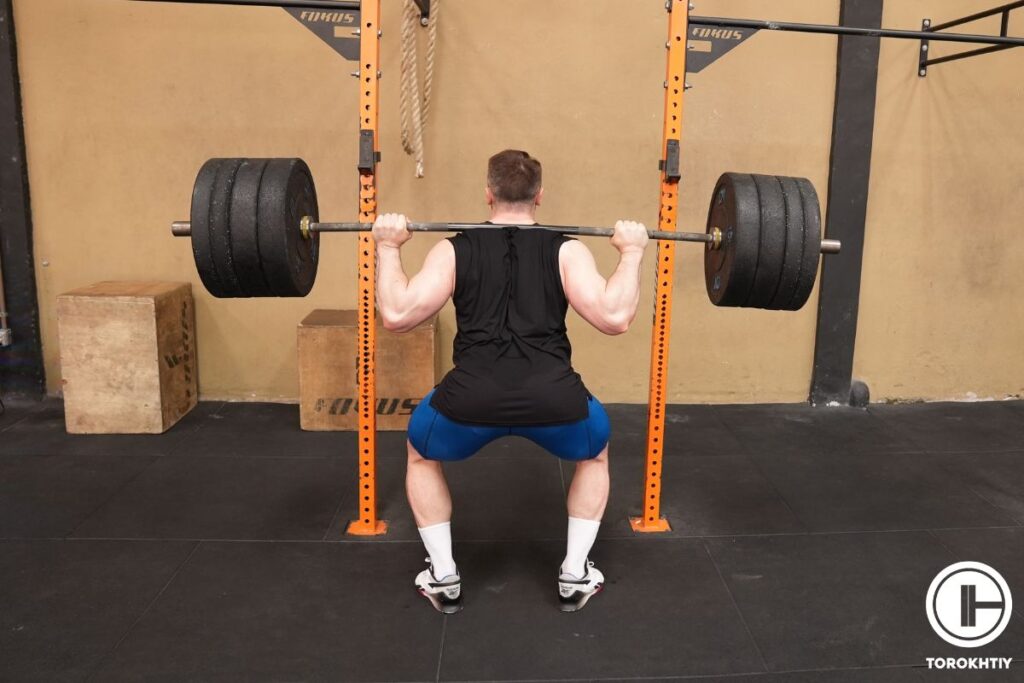
Step 4: Wide Grip vs Close/Narrow Grip
A wide grip might lead to more lateral bending and it’s more common with people who don’t have enough shoulder mobility. The close/narrow grip brings your hands closer together on the bar, which activates your back more and keeps your spine secure. Feel free to experiment, though, because stability is still important, it’s not only about which muscles are engaged.
Step 5: High Bar vs Low Bar
The last choice you need to make is between the high bar and the low bar position. The high bar rests on the upper traps and it makes it easier for you to keep your posture upright. Another thing that’s great about it is that it does a great job of engaging your quads. Low bar squat, on the other hand, sits lower on the back, engages your posterior chain, requires more hip flexion and less knee flexion than high bar . The best thing about it is that it can make it easier to lift heavier weights.
With this, you need to go with what you like better and what your goals are. High bar squats are popular with people whose priorities are general strength and athleticism, and low bar squats are more common with powerlifters who want to lift heavier loads. Try them both out and see.
5 Most Common Hand Position Mistakes When Squatting + Solutions
There’s a lot to look out for when you’re squatting, so it’s not surprising there’s also a bunch of mistakes you can make. Mistakes are part of the learning process so, in a way, you should appreciate them and learn from them.
Don’t drive yourself crazy trying to be perfect and avoiding mistakes. If you get familiar with the most common things that can go wrong (and how to fix them), you’ll learn faster, and the entire process will be easier.
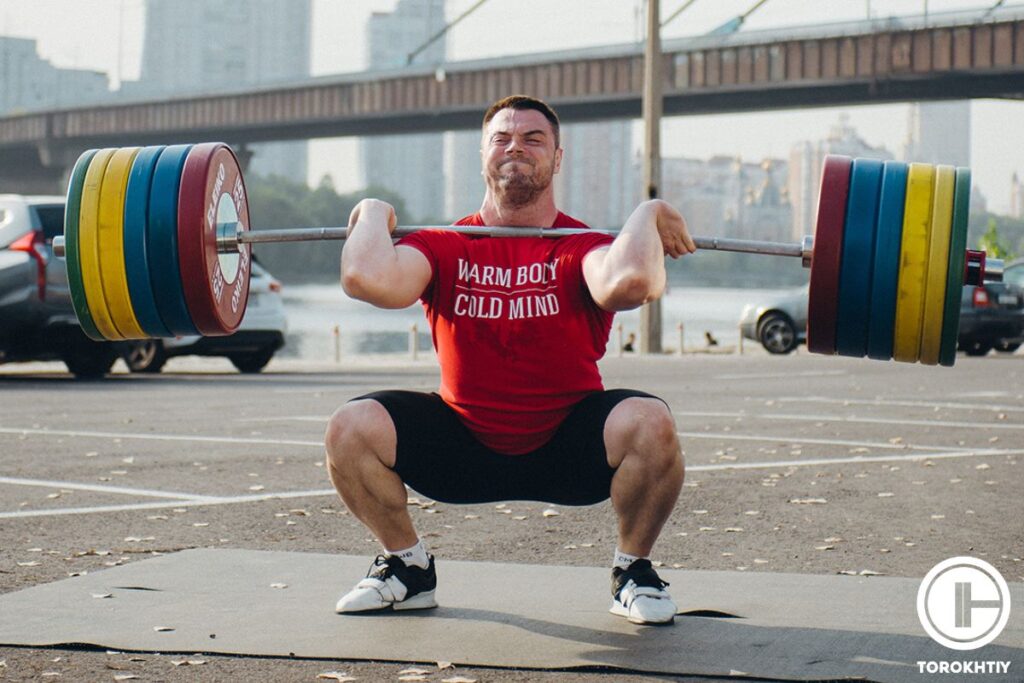
1. Grip Being Too Wide
A very wide grip can lead to less control and stability of the barbell, and it can really strain your shoulders.
Solution: Narrow your grip bit by bit until your shoulders are tight and engaged (but still comfortable). This will give you more control and it won’t compromise the health of your shoulders.
2. Grip Being Too Narrow
A grip that’s too narrow is not good either because it can strain your wrists and elbows. If you’re lucky, you’ll only feel discomfort, but you can actually end up injured
Solution: Adjust your grip gradually and make it wider. You want a position that doesn’t strain your wrists or elbows, but that still allows your upper back to be tight.
🔻GET A FREE PROGRAM DEMO: 12 Week Squat Program by Oleksiy Torokhtiy
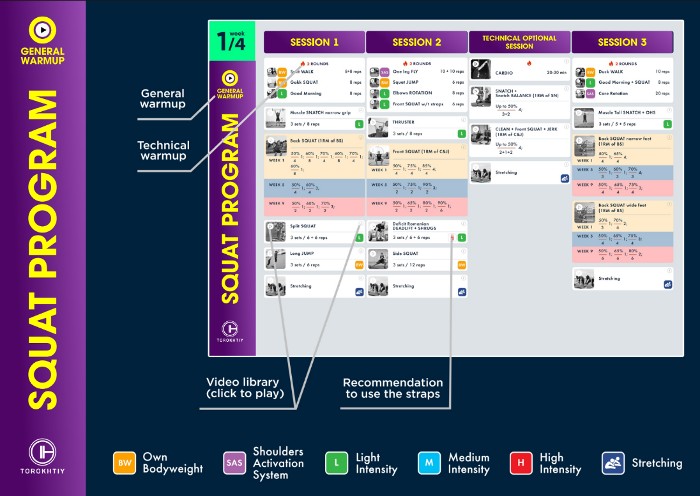
Do you want to double your squat strength? In just 12 weeks, you’ll be able to boost your squat results.
Enter your details and get a free demo (1 free week) of the squat program straight into your inbox.
3. Incorrect Hand Placement
If your hands are not placed properly in relation to the bar, your balance and posture will be off.
Solution: Make sure both of your hands are at the same distance from the bar’s center to make it secure and stable.
4. Elbows Flaring Too Much
If you let your elbows flare too much, it will shift the bar’s position, which will affect your balance and the depth of your squat.
Solution: Keep your elbows pointed down and back to keep the bar in its position and make your torso more stable.
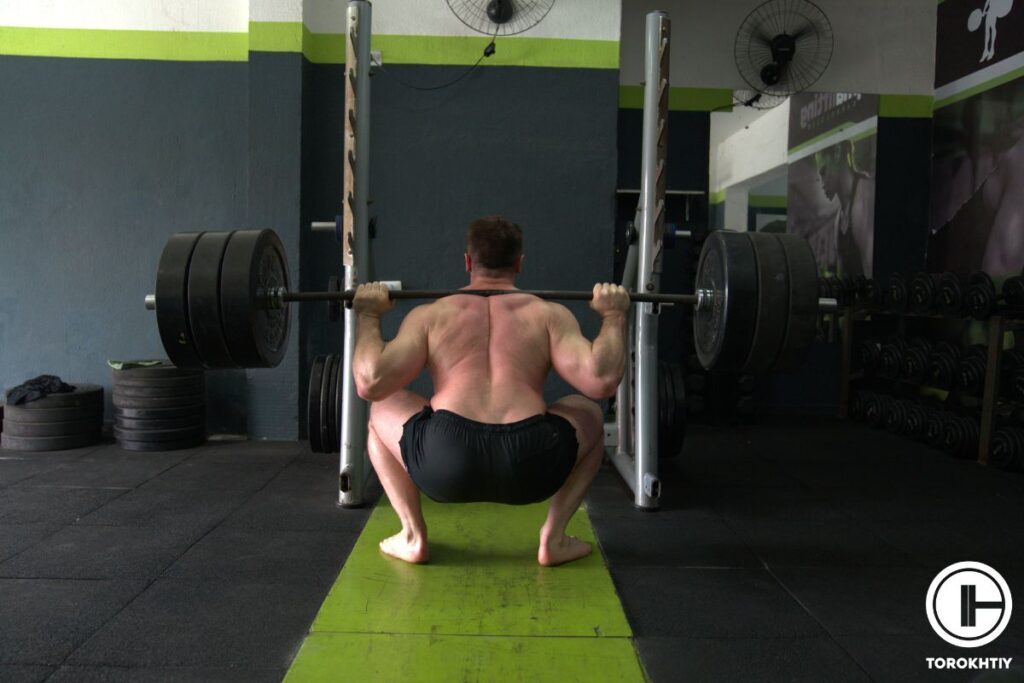
5. Not Engaging Your Upper Back
When your upper back isn’t engaged through shoulder and arm position, you will be at risk of rounding your spine and your squats will be a lot less effective.
Solution: Pull the bar into your back with a grip that allows for a tight, engaged upper back. This will reinforce your squat and make your posture more stable.
FAQ
Should you squat wide or close grip?
Choosing between a close or narrow grip squat depends on what feels right for you, but generally, go for a grip that is close enough to keep your upper back tight. Low bar squats will need a grip that’s wider than the one for high bar squats.
How should my wrists be when squatting?
Your wrists should be in a neutral position during squatting, and in alignment with your forearms. You may try to avoid excessive bending or deviation because that can cause injuries.
Where should I grip the bar for a squat?
You should place your hands evenly, a little bit wider than shoulder-width apart and choose a grip that feels secure. You’ll need to try a few of them out to see which one is best for you, but the regular grip is a great starting point.
Conclusion
Hopefully, you’re not overwhelmed with all of the information you got because this really boils down to what’s comfortable for you. How you place your hands plays a big part in what muscles get engaged and how comfortable the exercise feels, but as long as your form is okay and you’re mindful of your wrist position, you’re fine. Whether you try a regular grip or go for something fancy like a thumbless or talon grip, it’s about what feels good for you.
Watch out for pitfalls like improper depth and leaning forward too much, and most importantly, remember that this is a journey. Your trainer, that buff guy at the gym you admire, or a celebrity weightlifter you follow on Instagram, none of them mastered the squats overnight. It takes time, patience, and a tweak here and there to make them work for you.
What’s your go-to squat grip? How do you make your wrists happy during squats? Do you have any tips on how to find that sweet spot for the bar on your back?
Leave a comment and then squat on, friend!
Also Read:
- Spotter’s Handbook: How to Spot a Squat?
- 8 Squat Cues For Perfect Form And Strength
- Bench Press Wrist Position: The Beginner’s Guide
- How To Choose The Best Squat Wedge
- Squat Bar Placement: Does It Matter?
- Safety Bar Squats: Form & Benefits Explained
References:
- Eirik Kristiansen, Stian Larsen, Markus E. Haugen, Eric Helms, and Roland van den Tillaar “A Biomechanical Comparison of the Safety-Bar, High-Bar and Low-Bar Squat around the Sticking Region among Recreationally Resistance-Trained Men and Women,” International Journal of Environmental Research and Public Health 18, no. 16 (2021): 8351.
- Gregory D. Myer, Adam M. Kushner, Jensen L. Brent, Brad J. Schoenfeld, Jason Hugentobler, Rhodri S. Lloyd, Al Vermeil, Donald A. Chu, Jason Harbin, and Stuart M. McGill “The back squat: A proposed assessment of functional deficits and technical factors that limit performance,” Strength and Conditioning Journal 36, no. 6 (2014): 4-27.
- Roland van den Tillaar, Tom Roar Knutli, and Stian Larsen “The Effects of Barbell Placement on Kinematics and Muscle Activation Around the Sticking Region in Squats,” Frontiers in Sports and Active Living 2 (2020): 604177.
- Wei Wei, JingX Zhu, Shuang Ren, Yih-Kuen Jan, WuL Zhang, Ronghai Su, & Li He “Effects of progressive body-weight versus barbell back squat training on strength, hypertrophy and body fat among sedentary young women,” Scientific Reports 13, Article number: 13505 (2023).
- All photos are made by our Torokhtiy Media Team
Why Trust Us?
With over 20 years in Olympic weightlifting, strength training, nutrition coaching, and general fitness our team does its best to provide the audience with ultimate support and meet the needs and requirements of advanced athletes and professional lifters, as well as people who strive to open new opportunities and develop their physical capabilities with us.
By trusting the recommendations of our certified experts in coaching, nutrition, and sports training programming, as well as scientific consultants, and physiotherapists, we provide you with thorough, well-considered, and scientifically proven content. All the information given in the articles concerning workout programming, separate exercises, and athletic performance, in general, is based on verified data.
The product testing process is described in more detail here.
Author: Jacek Szymanowski
Certified Nutritionist,
M.Sc.Eng. Biotechnology
Performance Architect,
Strength and Conditioning Specialist
With over 30 years of fighting experience, specialization in nutrition coaching for athletes, and expertise in metabolic health and dietary strategies, Jacek offers a comprehensive approach to optimizing your performance and well-being. Backed by a Master of Science degree in Biotechnology, Jacek remains at the forefront of scientific advancements, ensuring that his coaching is always evidence-based and up-to-date.
Reviewed by: Oleksiy Torokhtiy
Olympic Weightlifting Champion, PhD in Sport Science
Best Results: Snatch – 200 kg,
C&J – 240 kg
Oleksiy Torokhtiy is a professional athlete boasting 20 years of experience in Olympic weightlifting. With multiple European and World titles under his belt, he has showcased his prowess in two Olympic Games (Beijing 2008 and London 2012). Upon concluding his illustrious career, Oleksiy dedicated himself to coaching. By 2022, he had conducted over 200 weightlifting seminars worldwide. He is the visionary behind an international sportswear and accessories brand known for its motto, “Warm Body Cold Mind.” Additionally, he is an esteemed author and the creator of a series of training programs and eBooks.





Still have questions after reading our article? Unlock your full potential by engaging with our experts and community! Don’t hesitate — leave a comment below and Jacek Szymanowski will provide a personalized answer and insights to help you reach your goals.